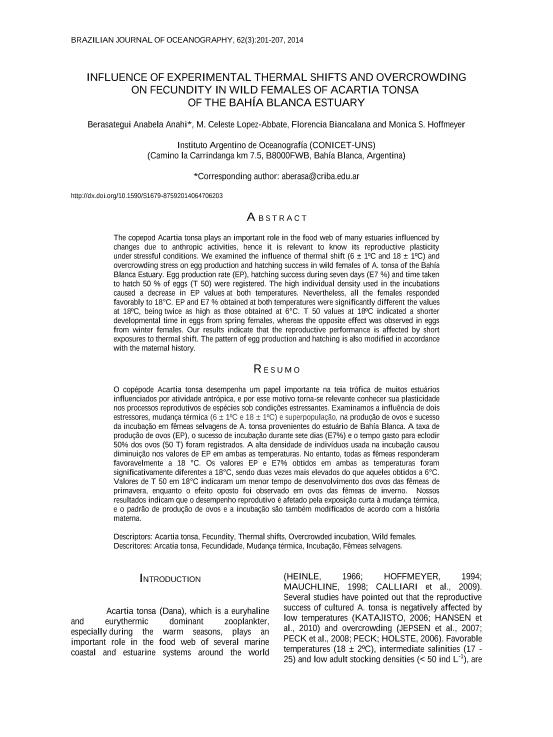Mostrar el registro sencillo del ítem
dc.contributor.author
Berasategui, Anabela Anhi

dc.contributor.author
Lopéz Abate, M. Celeste
dc.contributor.author
Biancalana, Florencia

dc.contributor.author
Hoffmeyer, Monica Susana

dc.date.available
2017-01-16T17:43:30Z
dc.date.issued
2014-09
dc.identifier.citation
Berasategui, Anabela Anhi; Lopéz Abate, M. Celeste; Biancalana, Florencia; Hoffmeyer, Monica Susana; Influence of experimental thermal shifts and overcrowding on fecundity in wild females of Acartia tonsa of the Bahía Blanca estuary; Instituto Oceanográfico; Brazilian Journal Of Oceanography; 62; 3; 9-2014; 201-207
dc.identifier.issn
1679-8759
dc.identifier.uri
http://hdl.handle.net/11336/11380
dc.description.abstract
The copepod Acartia tonsa plays an important role in the food web of many estuaries influenced by changes due to anthropic activities, hence it is relevant to know its reproductive plasticity under stressful conditions. We examined the influence of thermal shift (6 ± 1ºC and 18 ± 1ºC) and overcrowding stress on egg production and hatching success in wild females of A. tonsa of the Bahía Blanca Estuary. Egg production rate (EP), hatching success during seven days (E7 %) and time taken to hatch 50 % of eggs (T 50) were registered. The high individual density used in the incubations caused a decrease in EP values at both temperatures. Nevertheless, all the females responded favorably to 18°C. EP and E7 % obtained at both temperatures were significantly different the values at 18ºC, being twice as high as those obtained at 6°C. T 50 values at 18ºC indicated a shorter developmental time in eggs from spring females, whereas the opposite effect was observed in eggs from winter females. Our results indicate that the reproductive performance is affected by short exposures to thermal shift. The pattern of egg production and hatching is also modified in accordance with the maternal history.
dc.description.abstract
O copépode Acartia tonsa desempenha um papel importante na teia trófica de muitos estuários influenciados por atividade antrópica, e por esse motivo torna-se relevante conhecer sua plasticidade nos processos reprodutivos de espécies sob condições estressantes. Examinamos a influência de dois estressores, mudança térmica (6 ± 1ºC e 18 ± 1ºC) e superpopulação, na produção de ovos e sucesso da incubação em fêmeas selvagens de A. tonsa provenientes do estuário de Bahía Blanca. A taxa de produção de ovos (EP), o sucesso de incubação durante sete dias (E7%) e o tempo gasto para eclodir 50% dos ovos (50 T) foram registrados. A alta densidade de indivíduos usada na incubação causou diminuição nos valores de EP em ambas as temperaturas. No entanto, todas as fêmeas responderam favoravelmente a 18 °C. Os valores EP e E7% obtidos em ambas as temperaturas foram significativamente diferentes a 18°C, sendo duas vezes mais elevados do que aqueles obtidos a 6°C. Valores de T 50 em 18°C indicaram um menor tempo de desenvolvimento dos ovos das fêmeas de primavera, enquanto o efeito oposto foi observado em ovos das fêmeas de inverno. Nossos resultados indicam que o desempenho reprodutivo é afetado pela exposição curta à mudança térmica, e o padrão de produção de ovos e a incubação são também modificados de acordo com a história materna.
dc.format
application/pdf
dc.language.iso
eng
dc.publisher
Instituto Oceanográfico

dc.rights
info:eu-repo/semantics/openAccess
dc.rights.uri
https://creativecommons.org/licenses/by-nc-sa/2.5/ar/
dc.subject
Acartia Tonsa
dc.subject
Fecundity
dc.subject
Thermal Shift
dc.subject
Wild Females
dc.subject.classification
Otras Ciencias de la Tierra y relacionadas con el Medio Ambiente

dc.subject.classification
Ciencias de la Tierra y relacionadas con el Medio Ambiente

dc.subject.classification
CIENCIAS NATURALES Y EXACTAS

dc.title
Influence of experimental thermal shifts and overcrowding on fecundity in wild females of Acartia tonsa of the Bahía Blanca estuary
dc.type
info:eu-repo/semantics/article
dc.type
info:ar-repo/semantics/artículo
dc.type
info:eu-repo/semantics/publishedVersion
dc.date.updated
2016-12-01T19:38:49Z
dc.identifier.eissn
1982-436X
dc.journal.volume
62
dc.journal.number
3
dc.journal.pagination
201-207
dc.journal.pais
Brasil

dc.journal.ciudad
São Paulo
dc.description.fil
Fil: Berasategui, Anabela Anhi. Consejo Nacional de Investigaciones Científicas y Técnicas. Centro Científico Tecnológico Bahía Blanca. Instituto Argentino de Oceanografía (i); Argentina. Universidad Nacional del Sur; Argentina
dc.description.fil
Fil: Lopéz Abate, M. Celeste. Consejo Nacional de Investigaciones Científicas y Técnicas. Centro Científico Tecnológico Bahía Blanca. Instituto Argentino de Oceanografía (i); Argentina. Universidad Nacional del Sur; Argentina
dc.description.fil
Fil: Biancalana, Florencia. Consejo Nacional de Investigaciones Científicas y Técnicas. Centro Científico Tecnológico Bahía Blanca. Instituto Argentino de Oceanografía (i); Argentina. Universidad Nacional del Sur; Argentina
dc.description.fil
Fil: Hoffmeyer, Monica Susana. Consejo Nacional de Investigaciones Científicas y Técnicas. Centro Científico Tecnológico Bahía Blanca. Instituto Argentino de Oceanografía (i); Argentina. Universidad Nacional del Sur; Argentina
dc.journal.title
Brazilian Journal Of Oceanography

dc.relation.alternativeid
info:eu-repo/semantics/altIdentifier/url/http://ref.scielo.org/5rfyxk
dc.relation.alternativeid
info:eu-repo/semantics/altIdentifier/doi/http://dx.doi.org/10.1590/S1679-87592014064706203
Archivos asociados
